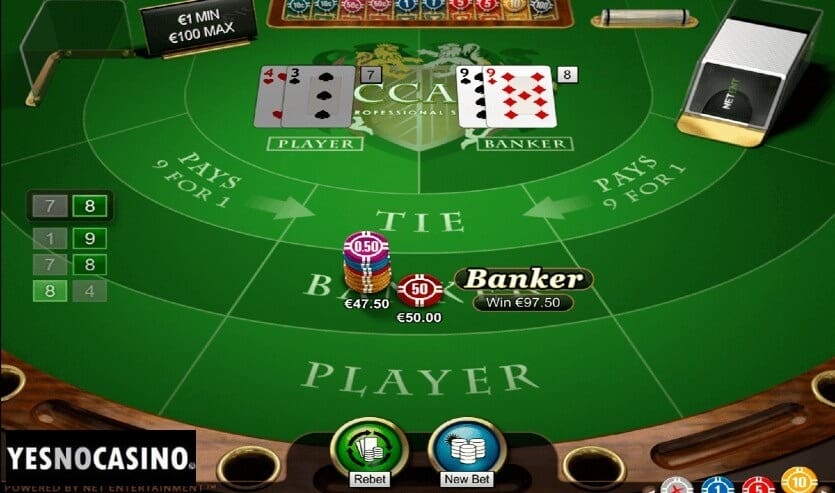
Baccarat is both one of the most famous and most mysterious games in a casino. Most regular gamblers at either online or land-based casinos have heard of baccarat, but, for some reason, relatively few seem to have actually played it.
The game has somehow gotten a reputation for being difficult to understand and learn. In reality, Baccarat is much less complicated than some of the more popular casino table games like craps or roulette. As you’re going to see, you can have a basic understanding of the rules and be ready to sit down and play in just a few minutes.
Btw, a fun fact: In Vegas, since 2019, Baccarat is second only to slot machines in terms of total bets placed, bypassing Blackjack.
Before we start, here is our list of Best Baccarat casinos online.
Best Online Casinos to Play BlackJack
Ignition Casino
100% up to $1,000 Bonus
- 24 hour payouts with Rapid Transfer and Bitcoin
- Biggest Casino and Poker room on the market
- Run by the most reputable company (sister to Bodog, Bovada, Slots LV)
Slots LV Casino
$5000 Welcome Bonus
- 24 hour payouts with Rapid Transfer
- Best casino for Slots Players
- Sister to Bodog, Bovada, Ignition
Café Casino
250% Welcome Bonus
- 24 hour payouts with Rapid Transfer and Bitcoin
- Highest Welcome Bonus
- Multi software casino with huge variety of games
Cherry Jackpot
400% up to $4,000 X2 Bonus
- Withdrawals: 3-5 days
- Best New Casino
- 300 RTG online slots
How To Play Baccarat At Your Favourite Casino
Baccarat is really quite similar to Blackjack in many ways. It is played with multiple decks of cards and the winning hand is determined by which one comes closest to the target value. In Baccarat, that target is nine. The main differences are that only two hands are dealt and all players at the table bet on those hands, trying to predict which hand will win or if they will tie.
Dealing The Cards And Placing Bets In Baccarat
The dealer will deal two hands for each game of Baccarat. One hand is called the banker’s hand and the other is the player’s hand. Whichever hand comes closest to a total of nine based on the card values is the winning hand. Players can bet that the winner will be the banker, the winner will be the player, both hands will tie, or any combination of the three.
The banker and player designations are somewhat misleading. The player actually has no say in what happens with the cards. All cards are dealt according to specific rules. As a player, you are simply betting on which hand will win. The hands could just as easily be referred to as “Hand A” and “Hand B” or “Hand 1” and “Hand 2”. Neither hand really belongs to anyone.
How To Determine The Value Of A Baccarat Hand
Again, similar to Blackjack, each card in the deck has a specific value. In Baccarat, aces are worth 1, all numbered cards are worth their face value, and tens and face cards are worth zero. The value of the cards is added together to determine the overall value of the hand.
As opposed to games like Blackjack, however, the total limit for the value of a hand in Baccarat is nine. If the total of the cards in either hand is ten or more, then the first digit is removed to get a single-digit value. So, for example, if a hand added up to 12, the 1 would be removed and the value becomes 2. If the total adds up to 18, the final value would be 8. And yes, if the cards in a hand add up to 10, the value becomes 0.
The Rules Of The Deal In Baccarat
This is the part of the game that most people find confusing. Each hand can have either two or three cards. The player and banker hands each have their own set of rules that state how the cards are to be dealt.
In the end, it’s not really important if you have these rules memorized or not. The dealer will always follow them and you will always have the same choice of wagers. Since you have no input on the game, the outcome is going to be the same whether you know how you got there or not.
The cards are dealt out with the player receiving the first card, then the banker hand receives its first card. The second cards are dealt the same. Depending on the value of the hands after the first two cards, one or both hands may receive a third card.
If either the player or banker is dealt a hand with a value of 8 or 9 on their first two cards, this is referred to as “a natural” and both hands will stand. If this doesn’t happen—which is most of the time—the hand will continue according to the rules below.
If there is no natural dealt, the rule for the player hand is simple. If the player has a value of zero through five, another card is dealt. If the value is six through nine, the player stands with two cards.
The banker hand has slightly more complex rules. If the player stands with two cards, then the banker will follow the same rule as the player. If the player was dealt a third card, then the banker may take another card according to the following conditions:
- With a total of 2 or less, the banker always draws a third card.
- With a total of 3, the banker draws a card unless the third player card was an 8.
- With a total of 4, the banker draws a card if the third player card was 2,3,4,5,6, or 7.
- With a total of 5, the banker draws a card if the third player card was 4,5,6, or 7.
- With a total of 6, the banker draws a card if the third player card was 6 or 7.
- With a total of 7, the banker always stands.
After the cards are dealt, the total value of each hand is calculated as we explained above and winning wagers are paid. If the hands tie, bets on a tie are paid and other bets are returned.
Wagers, Odds, And Payouts In Baccarat
As was mentioned above, there are three possible wagers in Baccarat. You can bet on the player, the banker, or a tie. In each game, you can make one, two, or all three bets.
Assuming a game played with eight decks, which is what most casinos use, the probabilities of the three possible outcomes are:
- The banker hand wins: 45.86% – House edge of 1.06%
- The player hand wins: 62% – House edge of 1.24%
- Both hands tie: 9.51% – House edge of 14.44%
Payouts are normally 1:1 (even money) for the player bet. The banker bet, with its higher chance of winning, has a 5% commission taken on winnings. The payout is normally expressed as 19 to 20. Most casinos will pay 8 to 1 on the tie bet but some pay 9 to 1.
It’s worth noting that many casinos will say that the tie bet pays “9 for 1”, meaning they pay you back nine times your bet. This is, in fact, an 8 to 1 payout. They’re simply using wordplay to make it seem like they pay more. If they give you back 9, you’re getting 8 plus the original 1 that you bet. It’s 8 to 1.
Hopefully you also spotted the outrageously bad odds of winning on the tie bet and the enormous house edge that comes with them. To put it simply, you should never put money down on the tie bet at a Baccarat table.
Some Baccarat tables will also offer side bets such as wagering on either hand being dealt as a pair (two deuces, two fives, etc.). These side bets come with similarly bad odds and a high house edge. They should also be avoided if you want to get the most out of your money.
So What IS The Best Bet At A Baccarat Table?
Even though the house takes a 5% commission on winnings from betting on the banker, it is still the best bet available. All of the bets have a house edge, but that edge is the smallest when you put your money on the banker.
Some will say that it’s possible to turn things around and actually gain an edge over the casino in Baccarat, and perhaps you can, but that’s a topic for another time.
For now, you should have a good understanding of the game and all the information you need to have a great time playing. You’re sure to see Baccarat tables in any land-based casino and most online casino sites. Give it a try and you just might find that you’ve found a new table game to fall in love with.



